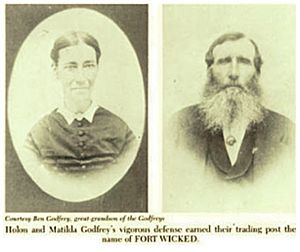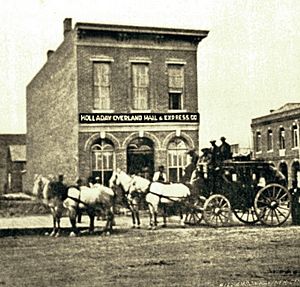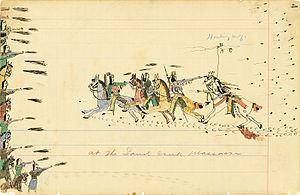Fort Wicked facts for kids
Quick facts for kids
Fort Wicked,
also known as Godfrey Ranch |
|
|---|---|
|
Civilian fort
|
|
| Country | United States |
| State | Colorado |
| County | Logan |
| Town | Merino |
Fort Wicked was a special ranch and stage station in Colorado. It operated from 1864 to 1868. This important spot was along the Overland Trail, also known as the South Platte Trail. Today, you can find a historical marker for Fort Wicked near Merino, Colorado.
The ranch was close to a place where people could cross the South Platte River. It was one of the few places on the trail to Denver that survived an attack by Native Americans in 1864. People started calling it "Fort Wicked" because of the very strong defense put up by its owner, Holon Godfrey.
Contents
Building Godfrey Ranch: A Stronghold
Holon Godfrey was an adventurous person. He first went to California for the gold rush. Then he returned to his family in Wisconsin. Later, he joined the Pike's Peak Gold Rush in 1859. Around 1863, he settled in the Merino area of Colorado.
There, he started a farm. He built a house and a stable using sod, which is like thick grass and soil. Most of his seven children later joined him in Colorado.
A Busy Stage Station
In 1862, the Overland Stage Route began using the South Platte Trail. Holon Godfrey and his wife, Matilda, opened a stage station. This station was a rest stop and a general store. It was a busy place for travelers.
Holon Godfrey was also a blacksmith. He would buy tired horses from pioneers. After resting and caring for them, he would sell the healthy horses to other travelers. The ranch also offered lodging sometimes.
Turning the Ranch into a Fort
By 1864, there was a higher chance of attacks by Native Americans in the area. Holon Godfrey decided to make his ranch much safer. He turned it into a strong fortress.
He added gun ports between the adobe bricks of his house. These were small openings for shooting from inside. He also built a lookout tower on top of the house. A six-foot-high wall was built around the entire property. These changes made the ranch ready for defense.
The Sand Creek Massacre and Its Aftermath
On January 7, 1865, about 1,000 Cheyenne and Sioux warriors attacked Julesburg. This attack was in response to the Sand Creek massacre. At Fort Sedgwick, some Native Americans and soldiers were killed. The warriors took so much food from Julesburg that it took them three days to move it.
After this, three groups of Native Americans—the Arapaho, Cheyenne, and Sioux—attacked stage stations and ranches. These attacks happened along the South Platte Trail over six days. They killed more people than were killed at the Sand Creek Massacre.
They also burned buildings and cut down telegraph lines. They stole many horses and about 2,000 cattle. They even looted wagon trains, including one with 22 wagons.
The Attack on Godfrey Ranch
Holon Godfrey and his family bravely defended their ranch. This attack, known as the Raid on Godfrey Ranch, happened on January 15, 1865. About 130 Lakota and Cheyenne warriors attacked the ranch.
Godfrey, his family, and his ranch hands were ready. They had fortified their ranch for the attack. The warriors attacked, but they were met with gunfire from the cowboys inside. The attackers also set the grass around the house on fire. Godfrey quickly put out the flames with buckets of water.
A Night of Defense
The battle lasted all night until morning. The warriors tried different ways to get inside. They even tried to burn the house with flaming arrows. But all their attempts failed.
During the fight, a ranch hand named Mr. Perkins took a big risk. He left the fort to ride to Fort Morgan. His goal was to get soldiers or send a telegraph to Denver for help.
By morning, the tribesmen finally left. The bodies of 3 to 17 of their dead were found outside Godfrey's ranch. Fort Wicked was one of the very few ranches to survive the January 1865 attacks. The cavalry arrived after the Native Americans had already left. The nearby American Ranch was also attacked.
Different Accounts
A Cheyenne warrior named George Bent was part of these raids. He described the attacks on many ranches in the South Platte River valley. However, he did not mention an attack on Godfrey's Ranch.
Bent remembered that only three Native Americans were killed in all the raids. He said those three were Sioux warriors who died during an attack on a wagon train.
What Happened Next
After the big attack, Godfrey painted a sign. It read "Fort Wicked" and he put it on the gate of his fort. There was another raid in 1867, but the fort held strong.
The Godfreys left their ranch around 1868. This was when the Union Pacific Railroad reached Cheyenne, Wyoming. In 1869 or 1870, the Godfreys moved to the Platte River district. This area is near LaSalle, Colorado, south of Greeley. There, they raised animals and farmed.
Holon and Matilda Godfrey are remembered as pioneers in that area. The Godfrey ditch and Godfrey Bottoms are named after him. Today, nothing remains of the original ranch and stage station. However, a historical marker stands at the site. It is about three miles southwest of Merino.
Images for kids





